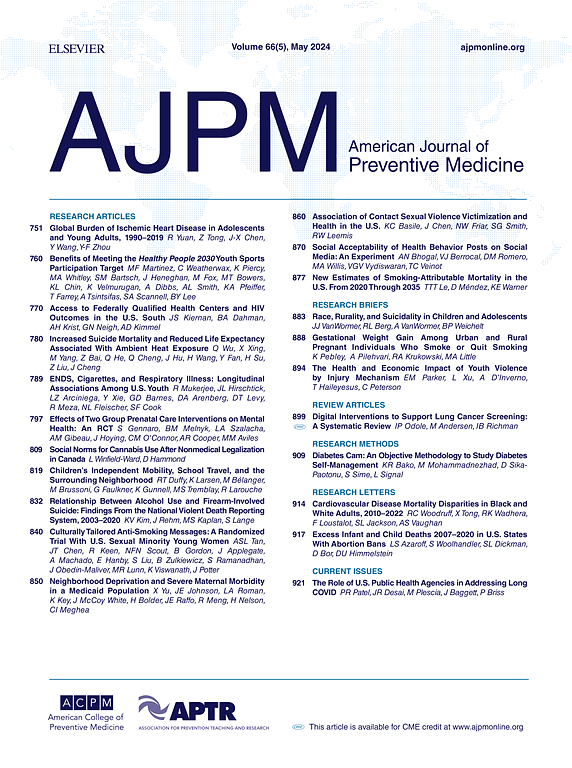Factors Associated With Mental Healthcare Utilization Among United States Military Personnel With Posttraumatic Stress Disorder or Depression Symptoms
IF 4.3
2区 医学
Q1 MEDICINE, GENERAL & INTERNAL
引用次数: 0
Abstract
Introduction
Although posttraumatic stress disorder (PTSD) and depression are prominent mental health conditions affecting United States service members, only a subset of individuals with these conditions utilize mental healthcare services. Identifying factors associated with mental healthcare utilization may elucidate military subgroups with unmet mental healthcare needs.
Methods
Cross-sectional survey data from the 2019–2021 Millennium Cohort Study assessment were used to examine correlates of unmet mental healthcare needs among military personnel who screened positive for PTSD or depression symptoms (n=18,420) using modified Poisson regression models. Data analyses for this study were conducted between 2023 and 2024.
Results
Approximately 32%–43% of service members reported receiving any mental health care in the past 12 months. Hispanic and Asian or Pacific Islander personnel and those with certain service characteristics (higher pay grade, recent deployment, experienced discrimination) had a lower likelihood of mental healthcare utilization. Female sex, greater symptom severity, experiencing bullying, and other psychosocial factors were associated with greater likelihood of mental healthcare utilization.
Conclusions
One third of service members with PTSD or depression symptoms reported any mental healthcare use, highlighting the need to identify factors that may impede or delay treatment. Racial and ethnic disparities in treatment utilization persist, as do differences in utilization by military characteristics. Further research and initiatives are necessary to identify potential service-specific or cultural barriers and provide equitable quality and access to needed mental health services within the Military Health System.
与有创伤后应激障碍或抑郁症状的美国军人使用精神保健服务有关的因素。
导言:尽管创伤后应激障碍(PTSD)和抑郁症是影响美国军人的主要心理健康问题,但只有一部分患有这些疾病的人利用心理保健服务。确定与心理保健利用率相关的因素可能会揭示出那些心理保健需求未得到满足的军人亚群:利用 2019-2021 年千年队列研究(Millennium Cohort Study)评估的横截面调查数据,使用修正的泊松回归模型,对筛查出创伤后应激障碍或抑郁症状阳性的军人(人数=18,420)中未得到满足的心理保健需求的相关因素进行研究。本研究的数据分析在 2023 年至 2024 年期间进行:大约 32-43% 的军人表示在过去 12 个月中接受过任何心理保健服务。西班牙裔、亚洲或太平洋岛民以及具有某些服役特征(薪资级别较高、近期部署、经历过歧视)的人员使用心理保健服务的可能性较低。女性性别、更严重的症状、遭受欺凌以及其他社会心理因素与更有可能使用心理保健服务有关:结论:三分之一有创伤后应激障碍或抑郁症状的服役人员表示使用过任何心理保健服务,这突出表明有必要识别可能阻碍或延迟治疗的因素。治疗利用率方面的种族和民族差异依然存在,军事特征导致的利用率差异也是如此。有必要开展进一步的研究和行动,以确定潜在的特定服务或文化障碍,并在军事卫生系统内提供公平的质量和获得所需心理健康服务的机会。
本文章由计算机程序翻译,如有差异,请以英文原文为准。
求助全文
约1分钟内获得全文
求助全文
来源期刊

American Journal of Preventive Medicine
医学-公共卫生、环境卫生与职业卫生
CiteScore
8.60
自引率
1.80%
发文量
395
审稿时长
32 days
期刊介绍:
The American Journal of Preventive Medicine is the official journal of the American College of Preventive Medicine and the Association for Prevention Teaching and Research. It publishes articles in the areas of prevention research, teaching, practice and policy. Original research is published on interventions aimed at the prevention of chronic and acute disease and the promotion of individual and community health.
Of particular emphasis are papers that address the primary and secondary prevention of important clinical, behavioral and public health issues such as injury and violence, infectious disease, women''s health, smoking, sedentary behaviors and physical activity, nutrition, diabetes, obesity, and substance use disorders. Papers also address educational initiatives aimed at improving the ability of health professionals to provide effective clinical prevention and public health services. Papers on health services research pertinent to prevention and public health are also published. The journal also publishes official policy statements from the two co-sponsoring organizations, review articles, media reviews, and editorials. Finally, the journal periodically publishes supplements and special theme issues devoted to areas of current interest to the prevention community.
 求助内容:
求助内容: 应助结果提醒方式:
应助结果提醒方式:


